Rhinoplasty in Iran | Price, Benefits and Cares

The most important sign of human beauty is the face, and one of the most important elements of the face, which is located in the middle and has a balancing role among all elements, is the nose. This is why rhinoplasty is one of the most popular cosmetic procedures, especially in recent years, all over the world.
This surgery is performed in many countries, but in 2022, Iran is one of the most popular destinations for this operation. As the religious capital of Iran, Mashhad is one of the most popular cities in Iran for health tourism purposes. The existence of religious and historical attractions, balanced climate, countless hotels, the best nose surgeons and specialized clinics in the field of cosmetic surgery have made Mashhad the first pillar of Iran's health tourism among Arab-speaking Muslim countries.
In general, the nose can be divided into four types: meaty, bony, semi-meaty and semi-bony. Nose surgeries are also divided into several types of natural nose surgery, fantasy nose surgery, semi-fantasy nose surgery, meat and bone nose surgery, and reconstructive nose surgery.
In this article, an attempt has been made to examine the details of rhinoplasty in Mashhad in 1401. Details such as:
- What is rhinoplasty?
- What are the stages of nose surgery?
- How much does nose surgery cost in Mashhad?
- Who is the best nose surgeon in Mashhad?
- Where are the best nose surgery clinics in Mashhad?
- And …
What is nose surgery?
Nose surgery is divided into different methods, each of which is related to a specific area of the nose (it will be mentioned later), but the most common type of this operation is rhinoplasty. Rhinoplasty is a cosmetic surgery of the nose that can bring your nose to the desired shape and form. In this surgery, the nose is usually split from the lower part (columella) and then the wings, cartilages and shape of the nasal bone can be changed according to the required changes.
Due to the huge impact of the shape of the nose on the beauty of the face and self-confidence of people, the nose job has many details. These details include changes in these parts of the nose:
- Reduce size : Reduce the overall size of the nose
- Change in the nostrils (size and position): asymmetry in the nostrils is one of the most common defects of most noses, which can be solved by nose surgery and changes in the nostrils.
- Changing the width of the nose: The width of the nose is different in different cultures and nationalities, and by changing this width, the shape of the nose can be changed in general.
- Fixing a nose hump: One of the most common appearance problems of the nose, especially in Aryan societies, is the hump on the nose, which has been common among Iranians since ancient times. This problem can also be easily solved in nose surgery.
- Changing the shape and angle of the tip of the nose: due to the great influence of the tip of the nose on the final shape of the nose, the surgeon can change the shape of the nose from natural to fantasy with the slightest change in the angle of the tip of the nose or sharpening it.
- Changing or correcting the nasal septum: By correcting this nasal septum, some breathing problems that have arisen due to various reasons such as heredity, accidents, special diseases or serious injuries are solved.
Of course, in addition to the primary appearance factors, the surgeon must also consider the important and key factors related to ethnicity or race in the final design of the nose, because without considering this key factor, the final shape of the nose may be different, despite the appropriate appearance. Physically, it is not suitable for the culture and nationality of the applicant.
However, some professional nose surgeons can change the appearance of the noses of people of different nationalities and races who are looking to change the appearance of their noses in the best way by taking specialized ethnology courses.

Nose surgery cost in Iran | Mashhad
Currently (in 2022), nose surgery in Mashhad varies between 1000 and 1500 dollars. But this price change depends on various reasons. Apart from the minor costs related to tests and pre-operative visits and the cost of drugs and post-operative visits, which are usually less than $200. Most of the cost of nose surgery is related to the surgeon's salary and hospital expenses for hospitalization. This cost may be different in some cities of Iran.
Top 10 Rhinologist in Iran | Mashhad
| Picture | Name | Approximate cost |
|---|---|---|
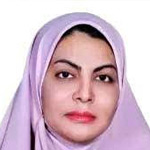 | Dr. Narges Razmara | 1200$ |
 | Dr. Mahdi Gholami | 1200$ |
 | ِDr. Hosein Hamedi | 1500$ |
 | Dr. Ahmad Ali Mosadeghi | 1500$ |
 | Dr. Mehdi Ramezani | 1000$ |
 | Dr. Nazanin Ebdali | 1000$ |
 | Dr. Ali Sarabi | 1500$ |
 | Dr. Ehsan Khadivi | 1200$ |
 | Dr. Karim Jalaeian | 1200$ |
 | Dr. Kamran Kawiani | 1200$ |
Note: For rhinoplasty in Iran, the cost of accommodation, visa and hospital should be added to the high costs, which usually doubles the above costs.
Factors affecting the cost of nose surgery
The two factors of expertise and experience of the surgeon are the main factors that play a role in determining his salary. The minimum specialty of a good nose surgeon is "Ear, Throat and Nose", which is a high specialty and naturally has a high salary. On the other hand, good nose surgeons usually have the experience of performing more than 1000 successful operations, and this factor is also effective in their salary.
On the other hand, due to the great influence of the nose on the beauty of the face and also the sensitivity of this part of the body in the respiratory system of the body, if it is operated by an inexperienced person, it may cause permanent abnormalities or respiratory problems or the desired form of the applicant may not be formed. So, as the old people in Iran have pointed out, "No expensive is unwise, no cheap is unreasonable" Unfortunately, some of these inexperienced surgeons charge a low fee for their work, but the risks that may arise from nose surgery by your inexperienced person threat is far more than worth the low cost received.
In general, the most important factors affecting the final cost of rhinoplasty are:
- The level of expertise of the surgeon,
- Volume of nasal problems
- duration of surgery,
- Surgical technique and method,
- City of surgery,
- Hospital service quality
Who is a good candidate for nose surgery?
Beautifying the shape of the nose can be a surgical or non-surgical operation, and deciding whether or not to perform a "nose job" depends on your individual needs and goals. People who are candidates for rhinoplasty may choose surgery for cosmetic or functional reasons. For example, one of the most common candidates for a rhinoplasty includes a nose with a large bump on the bridge or humpback nose, or a nose that is too large or too wide. Functional reasons may also include correcting a deviated septum for breathing problems or fixing a broken nose.
Performing rhinoplasty is a big decision and the decision and choice of procedure may be different for each patient. It is also essential that applicants and candidates for nose surgery are aware of the risks, side effects and recovery process. On the other hand, the physical and mental health of the patient is also one of the factors that are effective in the conditions of candidates for nose surgery. Many plastic surgeons prefer that their patients be informed and mentally and emotionally mature enough to make such a big decision.
What factors determine a good candidate for rhinoplasty?
Some of the factors that are effective in the suitability of the applicant for nose surgery include the following:
- Age of the applicant: Although in some special cases such as accidents and accidents, nose surgery may be performed at any age, but plastic surgeons recommend that patients be at least late teens or adults (more than eighteen years old), because at this age All skeletal growth and soft tissue of the face has been completed, and on the other hand, the applicant has reached the approximate range of intellectual maturity. On the other hand, most nose surgeons consider the end of the age range for nose surgery to be between 60 and 70 years old, because at this age the cartilages and skin of the nose do not have the proper conditions to tolerate this operation, and usually the nose operation does not have a good result.
- Physical health of the applicant: In general, applicants who do not have any specific medical diseases are good candidates for nose surgery. Patients with diabetes, heart disease, bleeding disorders, lung disease or high blood pressure should consult their doctor first, especially if they are looking for a rhinoplasty procedure.
- Positive and realistic expectation: Applicants who have realistic aesthetic and aesthetic goals and have a suitable mental and emotional attitude are also among the ideal candidates for rhinoplasty.
- Functional: Patients seeking surgery to correct functional nasal problems, such as nasal obstruction that interferes with breathing, are also good candidates because these problems are an essential health issue.
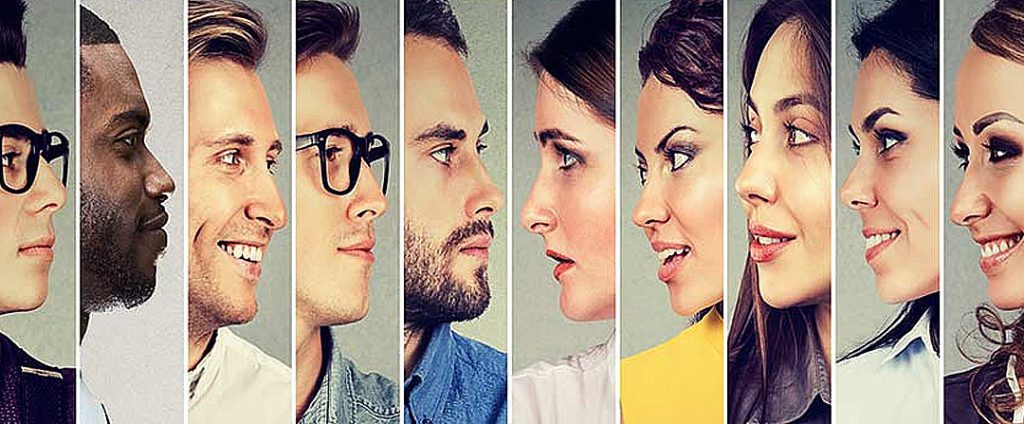
Who is nose surgery suitable for?
People who want to change the appearance of their nose for themselves and not for someone else!! These people are good candidates for nose surgery because ultimately it is the applicant who has to deal with the problems and results of this operation and live with its final results.
An ideal candidate for rhinoplasty (whether non-surgical or surgical) is someone who is in good overall health and has clear goals and realistic expectations. Such a person should not be suffering from diseases that prolong the healing process. For this reason, it is necessary to perform medical tests before surgery.
Each patient must understand that although an improved appearance can increase self-confidence, this new appearance will not necessarily bring him a better job or a better life partner. Each patient's nose has a different bone structure, nasal skin thickness, and nasal musculature, so there are limitations to the existing nose that determine what the surgeon can and cannot do. For example, one of the conditions that make the nose job more difficult is the operation of fleshy noses and thick skin. In such a case, the surgeon must perform the cartilage transplant operation to create a suitable infrastructure, and if the doctor does not have sufficient skills, the result of the operation will probably not be acceptable. These are the facts that the applicant must face before the operation.
But in general, the majority of people are suitable for rhinoplasty, and if you are a good candidate for rhinoplasty, this procedure can improve your appearance, increase self-confidence, and correct the functional problems of your nose.

Some nose problems for rhinoplasty:
- Crooked noses (protrusion in the middle bridge of the nose)
- Nasal septum fracture
- Asymmetry of the nose
- Hereditary big noses
- Noses with breathing problems
- Damaged noses in accidents
- The tip of the nose is large or wide
- wide noses
What people are at risk for nose surgery?
It is true that rhinoplasty is a completely optional procedure. But still, some people are not allowed to do this. This group of people should take responsibility for the possible consequences of nose surgery. The most important people for whom nose surgery is dangerous are:
- People with diabetes: In these people, due to the slow healing process of wounds caused by surgery, the applicant may face serious problems after the operation, the complications of which are uncontrollable.
- Respiratory disorders: Considering the fact that the patient is unconscious during surgery and the person can breathe only through the mouth, if there are previous breathing problems, serious problems may arise for people during the operation or even after the operation. .
- Smokers or alcoholics: Due to the negative impact of smoking and alcohol consumption on the immune system and the possibility of some unexpected events during the surgery, it is wise to stop consuming these items several months in advance if you intend to have a nose job. cut off
- Cardiovascular patients: Due to the use of general anesthetics for nose surgery and the possibility of allergic reactions to these substances, people with heart diseases may die as a result of these reactions. The most important thing about all the physical issues and problems of the patient is to inform your doctor about your problems, chronic diseases, allergies and medications so that the doctor can make the best decision about your operation.
- Suffering from acute anemia: Due to the aggressiveness of most nose surgery procedures and the possibility of bleeding during the procedure, people who suffer from acute anemia may show severe reactions when faced with this event, which may even lead to become sick to death
Revision rhinoplasty
In general, two types of surgery are called "Revision Nose surgery". The first type is related to noses that have had a primary surgery and for any reason are not satisfied with the result, or there are defects in the final result that cannot be resolved over time. In this situation, due to the weakening of the tissue and cartilages of the nose due to the primary nose surgery, it is usually more difficult for the surgeon to perform a secondary or reconstructive operation.
The second type of reconstructive operation is usually related to cases of repair and reconstruction of damaged nasal tissues due to accidents or severe burns, in which case the main goal of nose surgery is treatment.
Revision nose surgery, which is also called secondary surgery or Reconstructive rhinoplasty, can be done in open and closed ways, just like nose surgery.

Good candidate for revision nose surgery
In general, if the applicant is not satisfied with the apparent result of the primary surgery or feels that his breathing problems have not been resolved after the primary procedure, it becomes necessary to perform the secondary procedure. Some of the things that make revision surgery a basic necessity include:
- Deformation of the nose: If the surgeon does not use enough expertise and experience, the changes he makes on the nose during the operation may lose their effect over time and the applicant's nose will be even more deformed than the initial state before the operation. to be In this case too, choosing a reconstructive nose surgeon can be helpful and with a little luck, the applicant can achieve the ideal shape of his nose again.
- Remaining hump of the nose: Perhaps the most common problem that people experience after the initial nose job is swelling of the nose. But sometimes even after the swelling of the nose subsides, the nasal hump still exists on the bridge of the nose.
- Respiratory problems: The aim of nose surgery is to make the nose more beautiful by maintaining the respiratory function of this important organ of the body. If the person's breathing process becomes problematic after the primary nose operation or there is still a breathing problem, a secondary or reconstructive nose operation becomes necessary.
- Asymmetry of the nose: In some nose operations, after the swelling of the nose subsides and the final condition of the nose is revealed, asymmetry may be felt in some parts such as the nasal septum or nostrils. If this asymmetry is very obvious and disturbing, then again, the reconstructive operation can be untying and solve the problems of the primary nose operation.
- Small while the nose remains large: In some cases, the nose operation is aimed at reducing the size of the nose, unfortunately, the nose is still large after the operation. . In these cases, rhinoplasty by a rhinoplasty specialist can solve the problem to some extent.
- Keloid: Unfortunately, in some cases of nose surgery, due to the inexperience of the surgeon, fibrosis may occur at the place of the sutures, or "Keloid scars after rhinoplasty" as it is commonly called. If this case is acute, reconstructive nose surgery can be one of the The best options to solve the problem.
- Drooping nose tip: One of the biggest concerns that people have before nose surgery and they constantly ask their surgeon is the condition of the nose tip drooping after surgery. A professional surgeon is a surgeon who works by creating a suitable infrastructure under the nose shell in such a way that the results of the operation are permanent and do not lose their shape over time. People who suffer from drooping of the tip of the nose due to time can also think about nose reconstruction.
- Change in fashion and society's taste: Unfortunately, some people applying for nose surgery, instead of thinking about the fit of their nose with other parts of their face, behave more according to the society's taste and ask the surgeon to design their nose according to the current fashion. But what they are unaware of is that the human nose is not a garment that can be changed according to the fashion. These people are also looking for reconstructive nose surgery to change the shape of the nose again after the society's taste changes compared to the old-fashioned nose.
Very important point: Most of the problems raised in the initial nose surgery that were discussed were related to appearance problems, but some nose problems are related to damage to the olfactory nerves and may occur due to the surgeon's inexperience even in reconstructive nose surgery. It usually cannot be fixed. So be careful in choosing a suitable and experienced surgeon.
Types of nose surgery
Nose surgery is divided into different methods according to the area and the reasons for the operation, which can generally be divided into 4 final sections.
- Rhinoplasty: The most common nose cosmetic operation that leads to general structural modifications of the nose.
- Septoplasty: Correction of the middle septum of the nose, which is mostly related to breathing problems.
- Tip-plasty: modifying the shape of the tip of the nose, which has a great effect on the shape of the nose
- Alarplasty: correction of wide nasal lobes, which is done by reducing the width of these lobes.
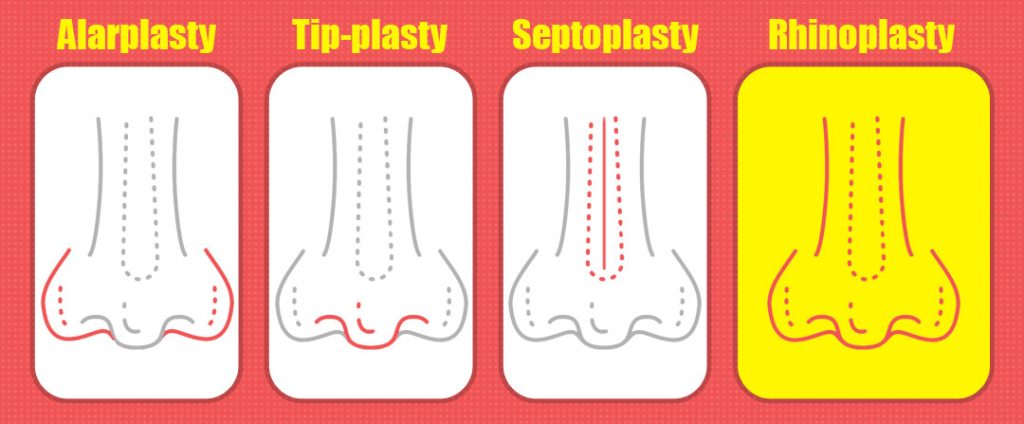
Rhinoplasty
The word “rhinoplasty” comes from the combination of two Greek words. The word root “rhino” refers to the nose. The verb “plasticos” means to effect change. Therefore, the combined word “rhinoplasty” literally means “to change the nose”. In rhinoplasty, the applicant's nose is split from the lower part (columella) and necessary changes are made to change the shape and correct the appearance and structural problems.
In rhinoplasty, the bone, cartilage, wings, and shape of the nose are generally changed as needed. In this procedure, by smoothing the cartilage and dividing bone inside the nose (septum) or correcting the nasal walls, people who are involved with breathing problems can be greatly helped.
With rhinoplasty, the following problems can be solved in applicants:
- General correction of the structure of the nose
- solving the problems of the tip of the nose,
- having two branches or onion skin on the tip of the nose,
- Asymmetry at the tip of the nose.
- eliminating the hump of the nose,
- Fixing a droopy nose
- correcting the angle of the tip of the nose with the lips,
- Fixing the long distance from the tip of the nose to the face,
- Correction of the width of the nose
The patient's anesthesia in this operation can be general or local according to the doctor's discretion, which general anesthesia used in most cases.
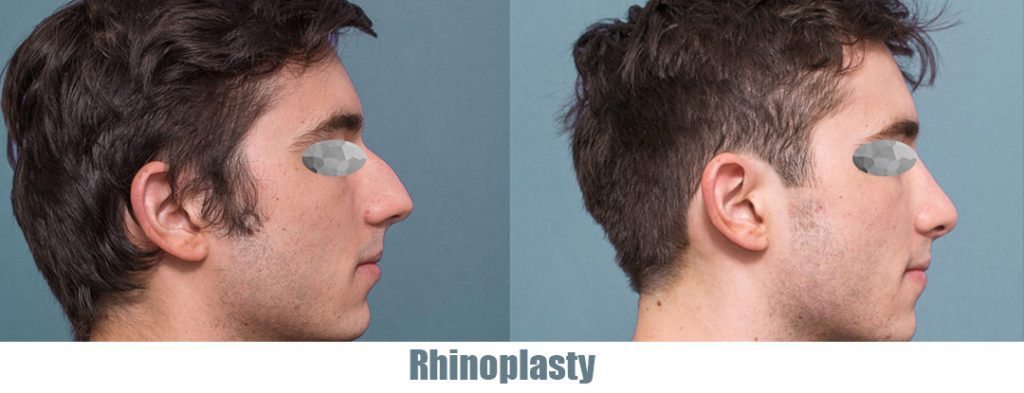
Who is the good candidate for rhinoplasty?
Most people have general conditions for nose surgery (intellectual and mental maturity), they usually have favorable conditions for rhinoplasty. The following people are good candidates for rhinoplasty:
- Correcting the functional and respiratory problem of beautiful noses without changing the appearance of the nose
- Deformities of the nose caused by accidents or accidents
- Fixing problems and congenital defects of the nose
- Creating harmony and proportion between the parts of the nose with other elements of the face
- Restorative operations to correct the primary operation of the nose
- Fixing the appearance problems caused by drooping of the tip of the nose
- Changing the transverse size of the nose by changing the size of the nostrils
Advantages of rhinoplasty
The main advantages of rhinoplasty are:
- Improving the process of breathing through the nose,
- Fixing asymmetry, large or small blades, humps and fractures,
- Increasing people's self-confidence to participate in society
- general correction of the shape and appearance of the nose,
- Increase facial harmony
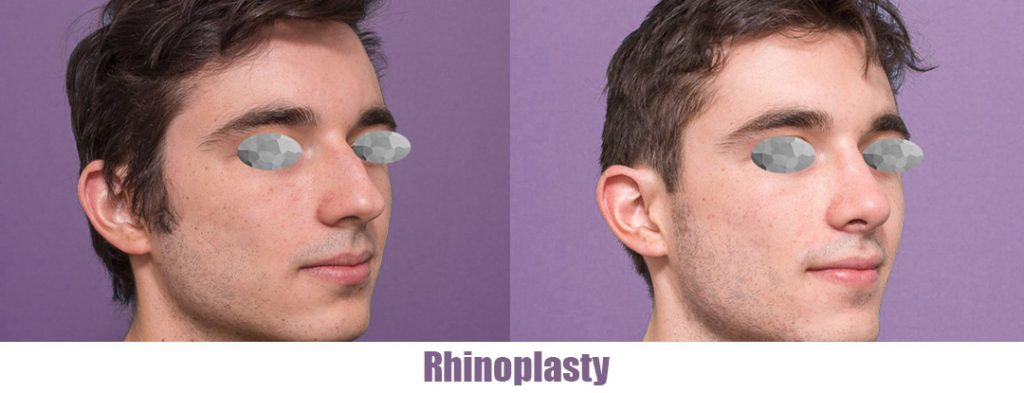
Disadvantages and possible complications
General point: nose surgery is generally not a dangerous procedure and does not have serious problems and complications, unless this procedure is performed in non-specialized centers or by inexperienced people. Some of the complications after rhinoplasty that may arise in this way include the following:
- damage to the olfactory nerve,
- Abnormal bleeding after surgery.
- Permanent loss of sense of touch in the nose
- Respiratory disorders,
- Skin ulcers
- Asymmetry of the nose
- The possibility of infection
How to perform rhinoplasty?
Considering that rhinoplasty is the most complete and common type of nose surgery, in the following sections, the complete process of this procedure will be explained as a cosmetic nose surgery.
Septoplasty
As mentioned earlier, septoplasty is another nose surgery procedure, this procedure is used to correct the deviation of the middle nasal septum. The septum is a wall made of cartilage and bone, which is located between two nostrils, and the lower part is cartilage and the upper part is bone. The deviation of the blade caused by the deviation of the septum to one side can cause many breathing problems for a person. Septoplasty is one of the nose operations that makes the process of air passage and breathing easier by straightening the deviation of the septum.
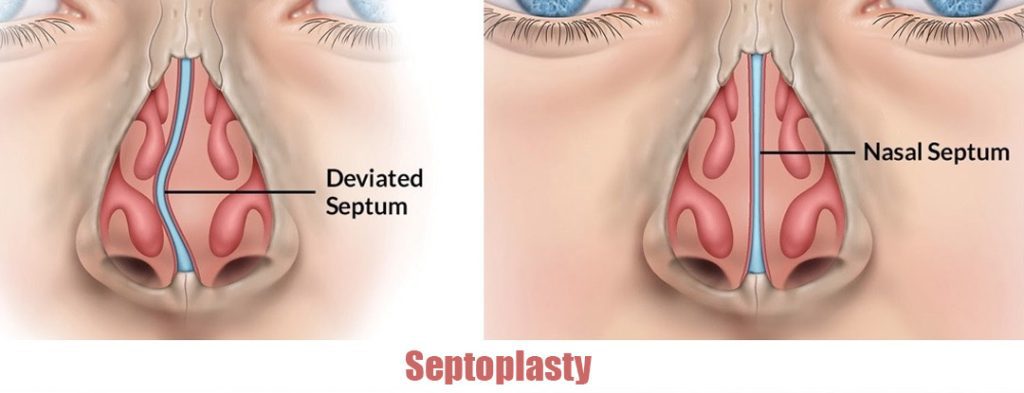
Deviation of the middle nasal septum may be congenital or due to accidents. Due to the fact that the nasal passages of people with septal deviation are smaller compared to other people, that's why the breathing process is more difficult in these people. Another symptom of a deviated septum can be pain in the face or frequent nosebleeds.
Who is the right candidate for septoplasty?
Like candidates for rhinoplasty, most people have general conditions for nose surgery, they usually have favorable conditions for septoplasty. The following people are good candidates for medial disc deviation surgery:
- Snoring in sleep
- Sinusitis
- Frequent bleeding from the nose
- facial pain
- dry mouth,
- Respiratory problems
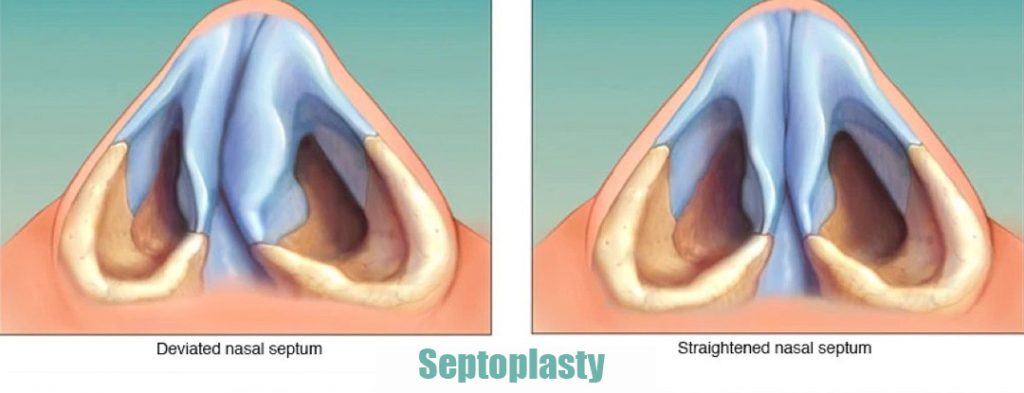
How to perform septoplasty
The septoplasty surgery will take about an hour depending on the patient's conditions and nose problems. Like rhinoplasty, this operation can be performed with local anesthesia or general anesthesia, and the diagnosis of each of these methods depends on the opinion of the surgeon.
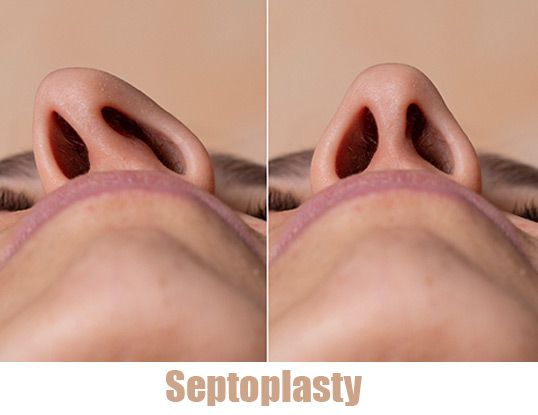
In this surgery, the surgeon makes an incision on one side of the nose and access to the middle nasal septum, raises the mucous membrane covering the septum and then transfers the deviated septum to the appropriate place. Any additional obstruction such as cartilage or bone that is causing the blade to deviate should be removed. After doing all the things and removing the additional obstacles that cause the deviation of the nasal septum, the membrane is returned to the first place. Although in most cases, tampons are used to hold the middle nasal septum, but in some cases, sutures are also used to prove the position of the septum and cartilages.
Obstruction of the nasal airway and feeling sleepy after septoplasty is one of the most common post-operative complications that most people experience. Nausea caused by anesthetics is another common side effect after surgery. Considering that in most cases the nostrils are blocked with a tampon to prevent bleeding, as a result, the air flow through the oral cavity will be the only way to breathe.
Care after septoplasty
The following items are effective in obtaining an ideal result from septoplasty:
- Use open-front clothes to prevent damage to the nose
- Restriction of heavy sports activities for at least two months after the operation
- Don't blow your nose
- Putting the head higher than the body when sleeping
Possible complications of septoplasty
Although all nose surgeries are among low-risk surgeries, you should also consider the possible side effects and adapt your expectations to these side effects.
- A hole in the middle lobe of the nose
- Persistence of respiratory problems
- profuse nosebleeds,
- Internal infection
- Problems with the sense of taste
- Problems with the sense of smell
- Numbness of the nose and teeth
Tip-plasty
In terms of anatomy, the word tip refers to the tip of the nose, and "plasty" means reconstruction or cosmetic surgery, and the work that is done during it is part of the process of complete nose surgery (rhinoplasty). So, in general, it should be said that this operation means cosmetic surgery on nose tip.
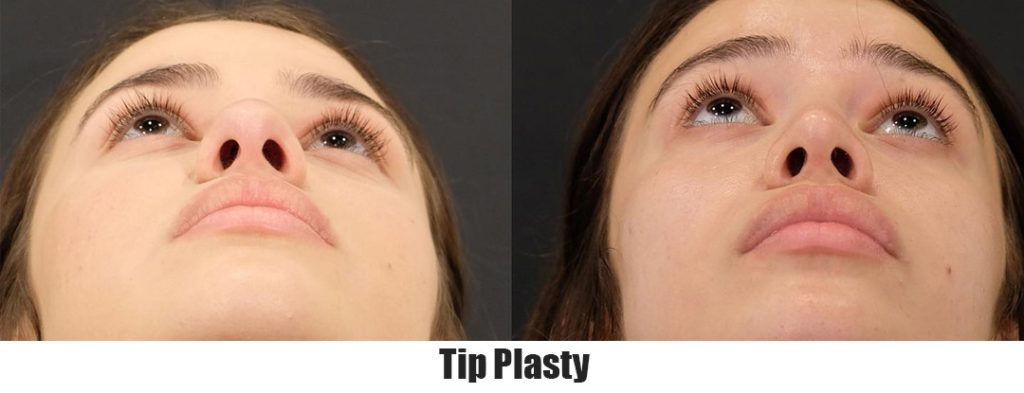
Unfortunately, in some cultures, it has been termed as such that only the tip of the nose can be corrected with tip plastic surgery, without performing other procedures, and also because of its cheapness, many people want it. Meanwhile, the applicant can only change less than 50% of his nose in this nose job; While in the complete operation of the nose (rhinoplasty), 100% of the structure of the nose can be changed.
Who is the good candidate for Tip-plasty surgery?
The nasal bone does not shrink in the tip-plasty; Therefore, this procedure cannot be performed for people who have a crooked nose or have too much hump or have a wide bony part of the nose. For such changes, you should refer to other nose cosmetic procedures.
In practice, less than 5% of nose job applicants are eligible for Tip-plasty surgery. Unfortunately, some applicants for nose surgery, due to a misconception, despite the presence of severe internal deviation, turn to tip-plasty surgery, which ultimately do not get good results from this surgery.
Alarplasty
As the septoplasty operation was related to the middle septum of the nose, Alarplasty Also known as nasal base surgery, is a surgical procedure most commonly performed to narrow nostrils that are overly wide. The Alar is the section of the nose where the nostrils become rounded and extend toward the cheek. Alarplasty is suitable for people whose nostrils are large or increase in size during breathing. Through this nose surgery, the size of the nostrils should be reduced or, if necessary, the symmetry of the nostrils is done.

In Alarplasty, a little bit of the skin of the nasal bridge is removed on the outer wall of the nose, which actually ends up making the nose narrower. One of the main applicants for this surgery are people who have fleshy or wide noses. The important thing about Alarplasty and Septoplasty is that both of these operations are actually a subset of Rhinoplasty.
Who is the good candidate for Alarplasty?
The limitations of this surgery are the same as other nose operations. But the following people could use Alarplasty instead of Rhinoplasty:
- Noses with asymmetrical nostrils
- People with large nostrils
- People with wide noses
- People whose nose gets bigger while breathing
- And finally, those who have been damaged in accidents
How is Alarplasty performed?
In general, the operation of Alarplasty and the care before it are the same as general operations of the nose, with the difference that this operation is less invasive than the Rhinoplasty.
The different stages of Alarplasty include the following:
- Consultation meeting and checking the details of the operation with the surgeon
- In order to maintain symmetry, the cutting place is first marked with a marker
- As with other nose operations, general or local anesthesia is used at the doctor's discretion
- Using the incisions made in the nasal lobes, the extra parts of the nose are removed.
- The edges of the nose will be connected to the correction site with sutures.
- Dressing the operation site

Recovery period of nasal base surgery (Alarplasty)
Considering that the percentage of invasiveness of Alarplasty operation is lower than other Rhinoplasty, as a result, the recovery period of this operation is also shorter compared to other nose surgeries. But like other nose surgeries, swelling of the nose is an integral part of the operation, of course, this swelling usually subsides after 2 weeks. After a week, you can go to the doctor to remove the stitches, and it usually takes between one and three months for complete recovery.
Alarplasty side effects
The side effects of Alarplasty surgery are also very low-risk like other nose operations, but in some limited cases there is a possibility of some problems. The most important complications of Alarplasty are:
- Oscar's effect
- Nasal infection
- Swelling of the nose
- Redness of the skin of the nose
- Slight bleeding from the suture site
Nose surgery methods
Nose surgery is generally performed in two ways, open and closed rhinoplasty. Usually, in the consultation session, the doctor chooses one of these two methods according to the conditions of the applicant's nose and checking his wishes and on the other hand the limitations of the operation. However, in the last few years, with the progress of medical science on the one hand and the practical power that the open method gives to the surgeon, most doctors choose the open method.
Open method Rhinoplasty
In the open nose surgery method, which is the most common nose surgery method, the skin of the nose is cut from under its middle blade (columella) and the skin of the nose is removed so that the surgeon can see the infrastructure of the nose, which is both cartilage and bone. After examining the infrastructure of the nose, examining the conditions of the applicant and his wishes, the surgeon begins to change, shave or break the bones or cartilages of the nose. After finishing the shaping of the nose, the surgeon turns the skin over the nose again and stitches it.

Open Rhinoplasty is practically the heaviest and at the same time the most common nose surgery due to the practical freedom and mastery it gives to the surgeon for structural changes of the nose. Of course, in some cases, such as fleshy or humped noses, the surgeon has no other option than open surgery, and this is the only method that meets the needs of the applicant. Due to being more invasive than other methods, open nose surgery has a longer recovery period and is usually more expensive than the closed method.
Closed method Rhinoplasty
Another and less invasive method of nose surgery is the closed method. In this method, which is less common, the changes in the nose are usually minor. In this method, through the slits that are created inside the nose, without removing the skin of the nose, the surgeon makes minor corrections in the middle part of the nose, such as removing the hump of the nose. But due to the fact that the skin of the nose is not removed and the surgeon does not have access to the tip of the nose, this method is not usually used for changing the tip of the nose, and for people who need to change the shape of the tip of the nose, surgeons choose the open method.
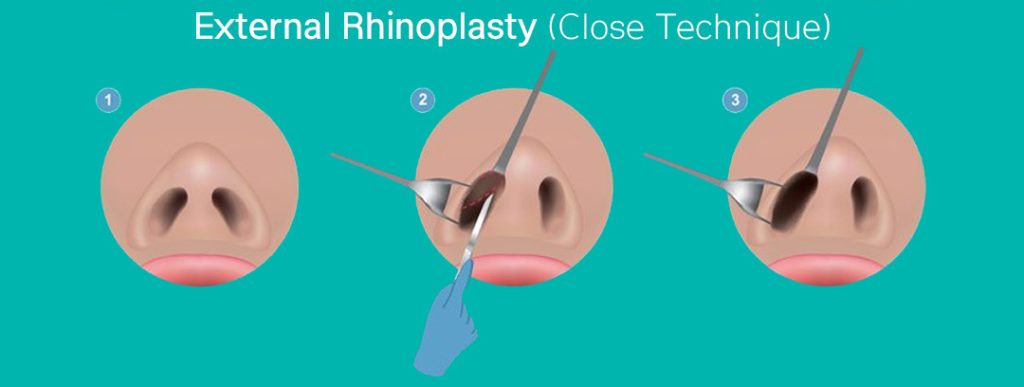
On the other hand, people who need minor changes in the nose and people who do not want the effects of nose surgery to be visible from the outside can be good candidates for closed nose surgery. In closed nose surgery, because it is less invasive, the recovery period is faster, the complications of the operation are less, and the cost is also reduced.
What is my nose type? fleshy or bony
With a little research about nose surgery, one of the first terms you will see on websites, articles, or even people's comments is the term fleshy or bony nose and some people ask "what is my nose type?". Generally speaking, there are two specific types of noses, fleshy nose and bony nose, and of course there is a third type which is the middle of these two types of nose.
But the origin of the difference between these two types of nose is actually the type and thickness of the skin on the nose. Noses with thicker skin are called fleshy noses, and noses whose underlying structure is more visible due to thinner skin are called bony noses.
Fleshy nose
The difference in the thickness of the skin and cartilage of these two types of nose makes all the conditions of nose operation different. In fleshy noses, due to the greater thickness of the skin and the wide and large cartilages at the end of the nose, the surgeon has less maneuvering power to pay attention to details, and also after the operation, the swelling of fleshy noses is more than normal, which is why the conditions of the operation It is not suitable for fleshy noses.

By slightly pressing the tip of your nose, you can easily recognize the general type of the nose. Due to the presence of active sebaceous glands under the thick skin of fleshy noses, subcutaneous fat can easily seep out from under the skin, which is not the case in bony noses.
Bony nose
But on the other hand, in bony noses, due to the thin skin, the nose bone is usually visible and the nose looks slightly humped. In these types of noses, due to the thin skin, the surgeon can implement desired changes on the nose. And these changes are well visible on the skin of the nose after the operation. Also, the swelling period of these types of noses is shorter, and nose job applicants can face the final results of the operation faster.

Stages of rhinoplasty
Rhinoplasty surgery is a process like other procedures, the beginning of which is the selection of an expert and experienced surgeon and the end of which is post-operative care. journey of rhinoplasty:
Who is the best nose surgeon near me?
The first step and almost the most important step of rhinoplasty is choosing the best nose surgeon who has the necessary skills and expertise and has the appropriate experience in this field. Choosing a good surgeon is the beginning of a successful rhinoplasty process and choosing the wrong surgeon is the beginning of your troubles. So be very careful in this choice!!
Searching the internet, social networks, asking friends and acquaintances and finally going to the desired doctor's office and talking about your wishes and expectations can help you in choosing the best possible surgeon. The cost of the initial visit to several doctors is much lower than the costs that you will have to pay in the future if you choose the wrong surgeon. So feel free to consult several doctors.
Pre Operation cares
After choosing a surgeon, be sure to discuss the details of your wishes with him or her so that the surgeon can make a proper assessment of your condition. On the other hand, try to look at the nose job realistically, because some of your wishes may not be met, and consider the honesty and openness of the surgeon regarding these limitations to his high experience. Also, in this meeting, try to inform the doctor about all your medical history and inform the good doctor about the medications you are taking.
After choosing the desired doctor and determining the operation time, the surgeon prescribes tests to diagnose your physical condition that you must perform. There are also cares that the surgeon usually warns you before the operation to follow in order to get a better result from the actual operation. Some of these cares include:
- Avoid taking blood thinners such as ibuprofen and aspirin two weeks before the operation
- Avoiding any kind of tobacco and alcohol two weeks before the operation
- Be sure to take a bath before the nose job. Because after this procedure, you will not be able to take a bath for some time.
- Eat a light dinner and try to fast 8 hours before the operation.
- Bring an open-front or button-up dress for after surgery.
How is rhinoplasty surgery?
In Iran, most of the surgeries are performed in most advanced hospitals. The time of surgeries also varies according to the conditions of the nose, but in general, nose surgery usually takes between 2 and 3 hours. The procedures for nose surgery in the operating room are as follows:
First stage: general anesthesia
Before rhinoplasty, the person is anesthetized to feel comfortable during the procedure.
Considering that most nose operations are performed in an open manner and this operation is considered an invasive operation, usually all doctors use general anesthesia for this operation. Although in some limited cases and the need for minor changes, the surgeon may also use local anesthesia for nose surgery at his discretion.
In less than 5 minutes after entering the operating room, you will be unconscious and will not feel any pain. After the surgery (2 to 3 hours) and going to the recovery room, you will regain consciousness.
Second step: cutting the nose
Rhinoplasty is done in two ways; open and close method. In the closed method, the incisions made are inside the nose and are
After you are completely anesthetized, the surgeon will start to cut parts of the nose according to the chosen method regarding the open or closed rhinoplasty. Nose skin incisions in the closed method are performed only inside the nose and internally.
But in the open method, incisions are made under the columella area and the surgeon raises the soft tissues of the nose called cartilage through these incisions. This work makes the surgeon fully aware of the condition of the nose and make desired changes on the nose.
The third step: shaping the nose
A part of the bones and cartilage of the nose is removed in noses that have other sizes. Sometimes during rhinoplasty, a
At this stage, the surgeon in crooked noses breaks the nasal bone either with a hammer or with some more modern methods such as ultrasonic waves (piezo rhinoplasty) and designs the appropriate arc of the nose. Then he can change the shape of the tip of the nose and other parts of the nose with the help of transplanted cartilages.
These donor cartilages are usually removed from the nasal septum, and if there is no suitable cartilage in the nasal septum, it can be extracted and used from the ear or rib cartilage. If the nasal septum is deviated for any reason, the surgeon should straighten and polish it. Finally, the surgeon checks the symmetry of the different elements of the nose and checks the openness of the airways and nasal cavities so that they are not blocked.
Fourth step: suture and dressing
When the structure of the nose is formed and the defects are removed, the skin of the nose is placed on the nose and th
After the ideal shape of the nose by the surgeon, it is time to stitch the cut areas. At this stage, the skin of the nose returns to its original state, inside the nasal cavity is filled with sterile gas or tampon to prevent bleeding.
After dressing the nose, usually a plastic piece is placed on the nose to fix and shape the changes made, called a nasal plaster or "nasal splint" according to the doctor's discretion. This piece is usually removed by the doctor after 7 to 10 days, and at that time you can see your operated nose for the first time.
Before and after nose surgery cares
The result of each operation is dependent on the expertise and experience of the surgeon, and it is the compliance of the prescribed instructions before and after the operation that makes the result of the surgeon's work well visible. Nose surgery, like other procedures, has pre- and post-operative care that must be followed.
Care before nose surgery
General care before nose surgery usually includes the following. However, for a better result, you must consult your doctor for these cares.
- Do not use aspirin two weeks before the operation.
- Avoid eating and drinking 8 hours before the operation.
- Drink enough water the day before the operation.
- Avoid smoking and hookah for at least 2 weeks before nose surgery.
- Take a shower the night before the procedure.
- Due to the movement restrictions after the operation, be sure to have a suitable companion with you for help.
- You should not wear any jewelry on the day of the operation.
- Fast on the day of the operation
- Bring your medical documents on the day of the operation.

Care after nose surgery
- Laughing and talking a lot for several weeks after the operation may damage the structure of the nose.
- Try to use watery foods that require less pressure to chew for the first two weeks.
- Refrain from being in crowded environments that may injure the nose for two weeks.
- Place your head higher than your body while sleeping after rhinoplasty.
- Avoid any heavy sports activities for the first two months after the operation.
- According to the doctor's instructions, use the nasal patch continuously for the first two months.
- If possible, in the first two weeks after nose surgery, try not to wear glasses or use lighter types.
- Avoid finning in the first month to drain internal nasal secretions.
- Washing serum is the best way to empty internal nasal secretions.
- 72 hours after the nose job, you should avoid taking a bath or a full head shower.
- Avoid using salt in food as much as possible.
- Include liquids, especially pineapple juice, in your diet for the first week to reduce swelling.
- Avoid sexual intercourse as much as possible for two weeks after rhinoplasty.
- Avoid playing with children who may hit their head and face in the first month.
- Manipulating the internal wounds of the nose has no other result than bleeding and the possibility of infection.
- Do not remove or manipulate the nasal plaster until you visit the doctor's office in the first week.
Swelling after rhinoplasty
The most important and biggest problem after nose surgery, which almost more than 90% of people experience, is "swelling after rhinoplasty".
This swelling is caused by the changes made by the surgeon on the tissues of the nose and is completely normal. The more these changes and corrections are, the more the swelling of the nose will be. The point that should be noted in general is that this inflation is different for people according to their conditions and individual characteristics. People with bony noses experience a shorter period of swelling (between 6 months and one year) and people with fleshy noses have a longer period of swelling (between one year and two years). Therefore, it is very important to adapt the level of our expectations and judgment towards the action with this timing and avoid hasty and emotional decisions.

To get familiar with the process of changes and swelling of the nose after surgery, we divide the recovery period after surgery into 3 parts:
- Recovery period (first week)
- Second week (removal of splint or cast)
- The first two months (general care)
Recovering
In general, the recovery period of nose surgery is about one week and the duration of dressing on the nose is between 7 and 10 days. The most important things to pay attention to during recovery are:
- In addition to the fact that swelling, bruising and pain in the nose and the surrounding area are completely normal, it may also be accompanied by nausea, dizziness and heart palpitations due to the reaction of the person's body to anesthetic drugs.
- On the third day after the operation, the intensity of bruising and swelling may increase, which is also completely normal. To reduce this pain and swelling in the first 3 days, you can use a cold compress and then a warm water compress.
- Curiosity about seeing the result of the operation in the first week may encourage you to open or manipulate the splint, which will cause serious and long-term damage to the final shape of the nose. Try to overcome your curiosity.
- Some mild bleeding is normal after rhinoplasty. If you face this condition, you can cover the nostrils with sterile gauze and keep your head up. Be sure to consult your doctor if the bleeding volume increases.
- Breathing is very difficult in the first 3 days after the operation because the nasal passages are closed. But over time and with the opening of the nasal airways through the washing serum, the situation will gradually improve.
- The changes that the surgeon makes on your face with rhinoplasty are like someone hitting you in the face with a fist on the street, so bruises and blackness under the eyes are completely normal and do not worry about it. Usually, these symptoms will disappear at the end of the first week.
- The most sensitive condition of the nose is the first week after surgery. Therefore, avoid any conditions that may cause nose damage in the first week. Because the nose has not yet stabilized its shape, and the smallest blow to the nose may be accompanied by bleeding or displacement of the cartilages. In case of a blow to the nose in the first weeks, be sure to consult your doctor. Many surgeons believe that your nose should not be touched for 6 to 12 months.

Second week (Cast Removal)
After seven to 10 days, at the doctor's discretion, the splint will be removed from your nose. Even after removing the cast or splint, your nose will still be swollen, which will reduce a lot after two weeks. At this time, all objects placed in the nose including splints and other dressings after surgery are removed by the surgeon.
From this time, the process of continuous taping of the nose begins for approximately two months (according to the doctor's discretion). The purpose of nose taping is to reduce the swelling of the nose more quickly and shape the nose. Try to install these adhesives exactly according to the doctor's instructions and replace them regularly as prescribed.
The first two months (general care after surgery)
Depending on the situation, some doctors may prescribe an instruction to massage the nose at this stage. First, follow this instruction carefully. Secondly, avoid arbitrary action for nose massage. Because every nose has its own conditions and your friend's or acquaintance's nose massage may not be suitable for you.
Avoid heavy sports during these two months. Walking and light exercises in which the head is kept high can be a suitable alternative to your heavy sports activities.
A month after the operation, a significant part of the swelling of your nose has decreased. Residual swelling may remain for up to a year, which is completely normal and seen in most nose surgeries. For this reason, you should wait at least a year to see the final results. Of course, this time may change according to the condition of your nose (bony or fleshy). Try to cope with this minor swelling during this period and avoid judging your nose job in the first year.
Avoid eating salty foods after nose surgery. Due to its high sodium content, salt will cause swelling and inflammation of your nose if it is too much in food. If you have other diseases or other dietary restrictions other than nose surgery, be sure to inform your doctor about this.
Side effects of rhinoplasty
It is true that with the advancement of technology, the possible complications and risks of surgical procedures have been greatly reduced in recent years, but in the case of nose surgery, two factors may lead to some possible complications:
Choosing an inappropriate or unauthorized surgeon or treatment center
Failure to comply with post-operative care.
The presence of problems in any of these factors increases the possibility of complications after the operation. Below are some possible side effects after nose surgery that you should be aware of:

- Swelling of the nose: Although swelling is one of the short-term complications of nose surgery, drinking celery and pineapple juice can solve this problem to some extent. But consuming too much salt may cause this swelling to last longer.
- Remaining scars and scars: In most cases, this complication is directly related to the lack of experience and lack of expertise of the surgeon. But it should also be noted that if you have chosen a suitable surgeon, it does not mean that all responsibility for the final result of the operation rests with the surgeon. Note that after completing the nose surgery in the hospital, your responsibility has just begun and you must pay attention to the doctor's instructions. So don't forget to use prescribed healing ointments to prevent the formation of wounds.
- Runny nose and sneezing: Some people may have a runny nose or sneezing for a few days after the operation. Be sure to sneeze with your mouth open during this time. You can use anti-allergy or cold medicine after consulting your doctor.
- Nasal indentation: If the surgeon has not designed the nasal infrastructure well and the nose does not have proper reinforcements, in the process of taping the nose to reduce swelling, indentations may be created in the nasal lobes, which in these cases should be treated with The doctor consulted and used restorative surgery if necessary.
- Breathing disorder: If the surgeon has narrowed the airways too much, you may have breathing problems. Never force the doctor to make your nostrils too small.
- Olfactory problems: Inflammation or swelling of the inner tissue of the nose and remaining secretions after nose surgery can lead to olfactory disorders. This is a normal complication, keep calm. When the nasal swelling is resolved, your sense of smell will return to normal.
- Intranasal adhesions: One of the side effects caused by the non-healing of intranasal wounds is the adhesions of the nasal canals. CT scan is necessary to check the exact cause of this complication.
FAQ about nose surgery
Who is the best doctor for surgery?
Considering that rhinoplasty is one of the invasive operations, as a result, the final shape of the nose is completely clear, and people can easily understand the doctor's expertise by seeing the appearance of the nose after the operation. Of course, in some special and deformed nose cases, even the best nose surgeons are unable to perform a stylish and beautiful operation.
But in general, you can choose the right doctor with the following factors:
- Research on the Internet and social networks
- Go to the office and inquire from previous applicants
- Initial visit and rhinoplasty consultation
- The level of reputation of the surgeon and the amount of referrals
What is the best age for rhinoplasty?
Most surgeons define the minimum suitable age for nose surgery as the completion of the growth period, which is about 18 years and the maximum age is about 65 years.
Can a hump nose be removed without surgery?
With some new methods such as injecting gel and filler into the nose, this problem can be solved to some extent and in a multi-stage manner, but the best permanent solution is still "nose surgery".
What foods improve the healing process of nasal cartilage?
Legumes, substances containing vitamin C, green tea, gelatin, pomegranate, eggs, cheese, nuts and brown rice are the best substances for cartilage repair.
Is nose surgery harmful for pregnant women?
Due to the negative effect of anesthetic on the health of the fetus, it is recommended to postpone nose surgery to a time before or after pregnancy.
What activities is a person allowed to do after nose surgery?
Until the end of the general care period (the first two months), you should refrain from doing any type of heavy activity.
How long should you avoid sex after nose surgery?
Most surgeons recommend that you refrain from sexual intercourse for two weeks after rhinoplasty.
Is it possible to wear glasses after nose surgery?
There is no obstacle to wearing glasses on the nose cast. But after the first week and removing the nose splint, it is better to use light glasses without frames.














Incidentally, I also heard that the cost of surgery in Iran is low. But is it possible to travel to Iran due to the problems of the region?
Yes, by the way, many clients from foreign countries are traveling to Iran right now. Both because of the tourist attractions and because of the beauty practices. Unlike some countries in the region, Iran is one of the safest places in the world to travel. You can search this issue
How long does it take to glue in the closed method? And whether there is less swelling in this type of operation?
you can ask doctors who we present them in CONSULTATION section.
I have a nose job for almost 6 month ago. but my swelling still is the same as was before. also I have a little hump on my nose. what is must to do. I’m so worry about it….
In general, you can not comment on rhinitis for up to a year. Wait, if your nose is still swollen after a year, see your doctor.